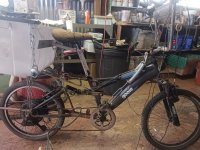dogfood
10 µW
Hi,
I have an old ebike from the 20teens I am trying to rehab. It's an old Em3ev (48V Mac 12t rear hub) kit and the controller failed (if that wasn't the original problem, it certainly is one now). The battery seems to be charging fine, and the hub motor was strong on its last ride (and was not ridden hard, though it has survived several NYC winter commute seasons). The switch and throttle probably need replacement from sitting in the elements.
The question is: Can I still find a controller that will plug and play with one of these Macs?
New Em3ev said to try Lyen and I haven't heard back. I bought a controller from Luna a few years ago, but I didn't know what I was doing then either, and it's for a Cyclone motor. I have a functional knowledge of wire splicing and household AC, but this whole "thing" (gesturing at the rat's nest) is a little overwhelming. I found a wiring diagram so it's not impossible...
Another question is: Is it worth it? I'm one component from just getting a new kit--if either the battery or the hub, old as they are, fails then I'm not sure it's worth splicing a bunch of tiny wires to salvage. If my sole purpose is the ride, I'd definitely buy an easy front wheel conversion, but there is a scavenger in me who wants to see this old and potentially good stuff put to use.
Third question(s): So, say I can't find a plug and play controller, what's the best way to test when you are starting with all variables? Breadboard, or wirenuts? What kind of connectors do you guys like for testing purposes? Is there a set that can deal with all the different gauges?
Look at my baby! Isn't she sweet? Goose, a.k.a. the Shambler.
I have an old ebike from the 20teens I am trying to rehab. It's an old Em3ev (48V Mac 12t rear hub) kit and the controller failed (if that wasn't the original problem, it certainly is one now). The battery seems to be charging fine, and the hub motor was strong on its last ride (and was not ridden hard, though it has survived several NYC winter commute seasons). The switch and throttle probably need replacement from sitting in the elements.
The question is: Can I still find a controller that will plug and play with one of these Macs?
New Em3ev said to try Lyen and I haven't heard back. I bought a controller from Luna a few years ago, but I didn't know what I was doing then either, and it's for a Cyclone motor. I have a functional knowledge of wire splicing and household AC, but this whole "thing" (gesturing at the rat's nest) is a little overwhelming. I found a wiring diagram so it's not impossible...
Another question is: Is it worth it? I'm one component from just getting a new kit--if either the battery or the hub, old as they are, fails then I'm not sure it's worth splicing a bunch of tiny wires to salvage. If my sole purpose is the ride, I'd definitely buy an easy front wheel conversion, but there is a scavenger in me who wants to see this old and potentially good stuff put to use.
Third question(s): So, say I can't find a plug and play controller, what's the best way to test when you are starting with all variables? Breadboard, or wirenuts? What kind of connectors do you guys like for testing purposes? Is there a set that can deal with all the different gauges?
Look at my baby! Isn't she sweet? Goose, a.k.a. the Shambler.




